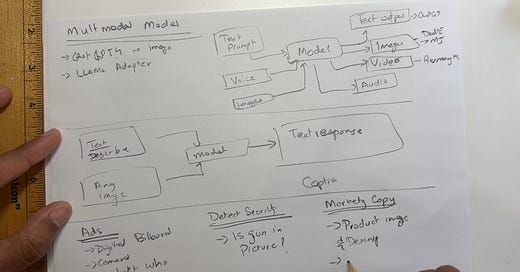In our fast-paced world, technology is evolving at an unprecedented rate. The fusion of artificial intelligence with diverse data sources has given birth to innovative models that are revamping industries. In my latest video, I take a deep dive into one such breakthrough - Multimodal Models. This article aims to be a written companion to the video, highlighting the core aspects discussed and the enterprise use cases of these models.
What are Multimodal Models?
To set the context, let’s first grasp what Multimodal Models are. These are AI models that can understand and interpret data from various formats such as text, images, and sound. Essentially, they’re adept at processing more than one type of data to perform tasks like translation, classification, and summarization.
In this video, I focus on a specific component of Multimodal Models - the Image + Text to Text. Here, the model takes both image and text data as input and generates text as output. This synthesis is immensely powerful and holds immense implications for enterprises.
Empowering Enterprises with Multimodal Models
Let’s now delve into some of the enterprise use cases that are explored in the video:
1. Advertising Revolution with Real-Time Customer Segmentation
Imagine walking into a store, and the digital advertising banners change to display products that pique your interest. This is possible through the combination of image processing and text generation. Cameras can segment customers based on various attributes and then generate personalized ads in real-time. This level of personalization not only enhances customer experience but also boosts the efficacy of advertising campaigns.
2. Enhancing Security with Threat Detection in Newsfeeds
In an era where information is abundant, it's crucial for security agencies and enterprises to sift through the clutter to detect potential threats. By integrating image and text analysis, multimodal models can scan newsfeeds, identify suspicious patterns, and generate summaries or alerts. This enables prompt action and strengthens security protocols.
3. Crafting Compelling Marketing Copy
For marketers, the challenge often lies in creating copy that resonates with the target audience. By analyzing images, such as those of the product or consumer demographics, and merging that with text inputs, the multimodal models can generate relevant marketing copy. This saves time and can be an indispensable tool for content marketers.
Beyond the Horizon: Other Use Cases
While the above applications are groundbreaking, the potential of Multimodal Models doesn't end there. One promising area is automated traffic and weather reporting. These models can analyze traffic images and weather data, then produce concise reports or alerts. This not only enhances the accuracy of the information but also makes the process more efficient.
The Takeaway
The integration of image and text data in Multimodal Models is carving new paths in enterprise solutions. From personalized advertising to enhanced security and ingenious marketing, these models are set to revolutionize how businesses operate. As we continue to innovate, the applications of Multimodal Models will only grow, making it an essential tool in the technological arsenal of enterprises.
If you like these videos be sure to subscribe to my newsletter.





Share this post